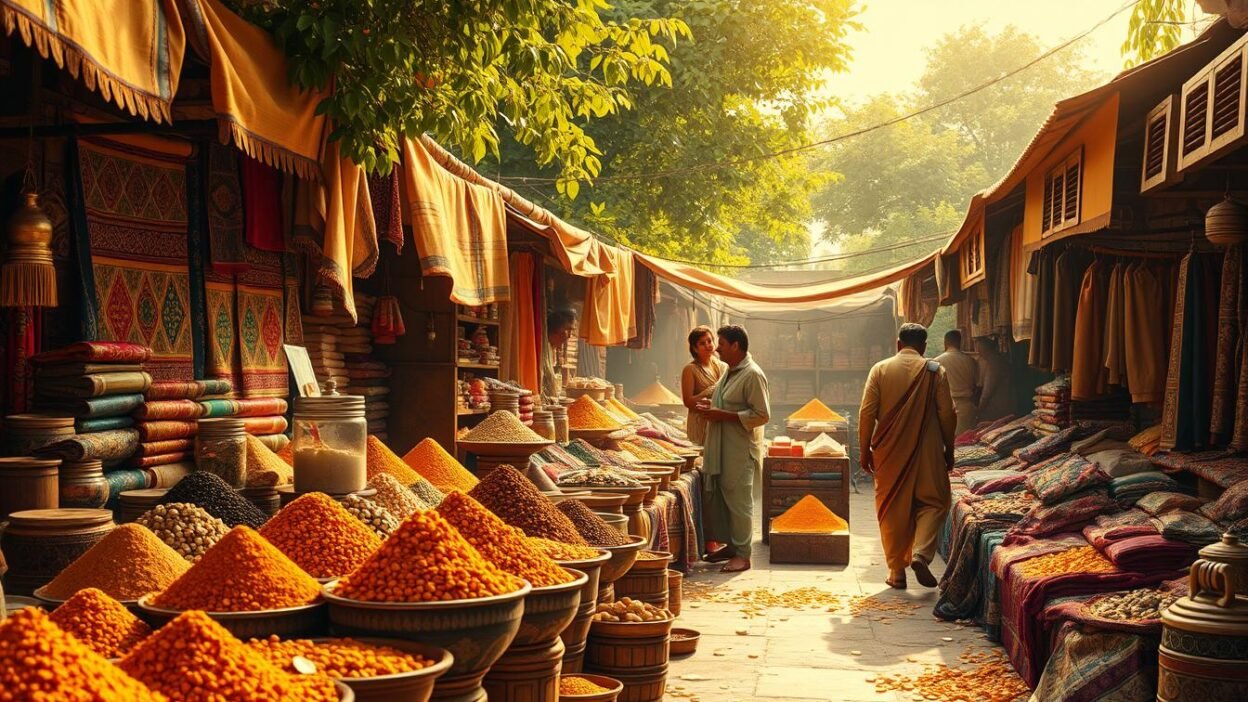What role did India’s ancient trade networks play in shaping the global economy long before the term “globalization” existed?
History shows that ancient India was a key spot for trade. Silk, spices, and valuable items moved across huge networks to Asia, Europe, and Africa. Routes like the Himalayan passes of Ladakh and the busy ports of southern India were vital. They didn’t just move goods; they also spread ideas, religions, and new technologies.
Trade in items like pepper, cotton, and gemstones made India a center of economic and cultural exchange. But how did these systems last for so long? They influenced art, governance, and more. This article looks at how geography, politics, and innovation made India a key player in early global trade.
Preparing for the UGC NET exam can be a daunting task, but with the right resources, candidates can navigate the process effectively. Websites like MyJRF provide a comprehensive platform for aspiring educators, offering specialized guidance for UGC NET Paper 2 preparation and essential tips for acing UGC NET Paper 1. Additionally, understanding the revised syllabus provided by UGC is crucial for a targeted study approach. For official announcements and updates, candidates should regularly visit the UGC NET NTA portal, while the UGC’s job section and the main UGC website are invaluable for post-exam opportunities and academic resources. With these tools, candidates can maximize their preparation and set themselves up for success. Preparing for Paper 1 and UGC NET Paper 2 Education requires a strategic approach with quality resources. UGC NET Education aspirants can access structured video lectures that cover essential concepts comprehensively. For an in-depth understanding, check out teaching aptitude videos and research aptitude guidance to strengthen your foundation. Additionally, higher education system topics and communication skills preparation are crucial for scoring high. Explore logical reasoning tutorials and mathematical reasoning lectures for better problem-solving skills. Enhance your exam strategy with people, development & environment lessons and ICT in education modules. For previous year papers and practice sessions, explore mock test videos and exam strategy tips. Stay ahead in your preparation with teaching methodology insights and subscribe to Educators Plus for expert guidance.
Key Takeaways
- India’s ancient trade routes predate many modern economic frameworks, blending commerce with cultural diplomacy.
- Goods like spices and textiles became vehicles for spreading religious philosophies and artistic styles.
- Ladakh’s strategic position on the Silk Route highlights how geography directly shaped trade patterns.
- Trade policies from empires like the Mauryas and Cholas established foundational principles studied today.
- Modern economic corridors, such as the New Silk Road, reflect enduring connections to these ancient systems.
Introduction to Ancient Indian Trade
Ancient India was a hub of trade and culture. From early exchanges with Mesopotamia to the Mauryan Empire’s road networks, historical events made India a key player in global trade. The Mauryan period (c. 322–185 BCE) was a key time, with rulers like Ashoka building the Grand Trunk Road.
This road connected the east and west, making sure goods and ideas moved freely across the land.
The Importance of Trade in Ancient India
Trade did more than just boost the economy. It helped society grow in three main ways:
- Economic Expansion: Trade money helped fund public projects and led to new ways in banking.
- Cultural Synthesis: Merchants brought new ideas and art, mixing local and foreign traditions.
- Political Stability: Empires used trade to keep their borders safe and show their power.
Overview of Major Trade Goods
India’s exports were famous for their quality and rarity:
- Spices: Black pepper and cardamom were loved in Roman kitchens and Ayurvedic medicine.
- Textiles: Fabrics from Tamil Nadu and Bengal were luxury items in the Mediterranean.
- Metals and Gems: Gold, diamonds, and ivory showed wealth in empires from Persia to China.
These trades, started by the Mauryan road expansions, helped India stay important in world commerce.
The Historical Context of Indian Trade Routes
The history of Indian trade routes is deeply connected to geography and politics. Ancient civilizations in the Indian subcontinent turned natural barriers into opportunities. They created networks that linked the Indus Valley to the Mediterranean. These networks thrived thanks to the use of terrain and imperial policies.
Influence of Geography on Trade Patterns
India’s physical geography greatly influenced its trade. The Himalayas and Thar Desert acted as natural barriers. River systems like the Ganges and Indus provided paths inland. Coastal areas, like the Malabar and Coromandel Coasts, connected to Southeast Asia and the Red Sea.
These features helped ancient civilizations build port cities like Arikamedu. There, Roman artifacts show maritime exchanges by 200 BCE.
- Mountain ranges: Protected northern regions while directing caravans routes southward.
- River valleys: Supported agricultural surplus that fueled trade.
- Coastlines: Enabled access to monsoon winds for long-distance voyages.
“Trade routes are the veins of a nation’s prosperity,” observed Kautilya in the Arthashastra, underscoring the link between geography and economic vitality.
The Role of Empires in Trade Development
Imperial governance played a key role in trade development. The Mauryan dynasty (322–185 BCE) built roads like the Uttarapatha. These roads connected Takshashila to Pataliputra.
The Gupta era (320–550 CE) standardized coinage and enforced trade laws. This boosted silk and gemstone exports to Rome. These empires showed how centralized authority could expand commercial reach.
The Silk Route: A Gateway to the West
The Silk Route was a key part of world history. It connected Asia and Europe with a network of paths over 4,000 miles long. It changed how goods and ideas moved between cultures, making India a central player. This part looks at how it started and the cities that made it important.
Origins and Expansion of the Silk Route
The route began in China’s Han Dynasty (206 BCE–220 CE) as a way to send silk. By the 1st century CE, it grew to reach the Mediterranean. Key moments included:
- Early Expansion (2nd–1st centuries BCE): Chinese envoys like Zhang Qian mapped routes to Central Asia.
- Roman Influence (1st–4th centuries CE): Roman demand for silk and spices drove westward extension into the Levant.
- Islamic Golden Age (8th–13th centuries): Arab traders expanded maritime and overland routes, boosting India’s role.
Key Cities Along the Silk Route
Urban centers along the route were key for trade and culture. Their strategic spots made them vital for exchanging goods and knowledge:
| City | Location | Role |
|---|---|---|
| Leh | Ladakh, India | Gateway between India and Tibet; salt and pashmina trade hub |
| Samarkand | Uzbekistan | Major caravanserai and silk distribution center |
| Bukhara | Uzbekistan | Knowledge hub for scholars and merchants |
| Chang’an | China | Eastern terminus; Tang Dynasty imperial capital |
These cities helped not just in trade but also in spreading religions like Buddhism and Islam. This made the Silk Route a key part of world history.
Spice Trade: The Jewel of Indian Commerce
Spices were the crown jewels of ancient Indian trade. They were in high demand worldwide for their taste, health benefits, and spiritual value. These aromatic goods connected India to other continents through sea and land routes.
Historical Significance of Spices
Black pepper, cardamom, and cinnamon were more than just flavors. They were key players in the economy. Their ability to preserve food and their healing properties made them valuable in global markets.
The Periplus of the Erythraean Sea, a 1st-century text, shows how Roman traders valued these spices. They traded gold and silver for them. Al-Hassan al-Wazzan, in the 16th century, wrote about India’s spice wealth. He showed how spices helped sustain empires.
Major Spice-Producing Regions in India
Kerala’s Malabar Coast and the Western Ghats were spice hubs. Their tropical climate was perfect for growing many spice varieties. Here are some key regions and their contributions:
- Malabar Coast: Black pepper and cardamom, key in Arab and European trade
- Karnataka: Sandalwood and cardamom, traded through ports like Bhatkal
- Andhra Pradesh: Cloves and nutmeg, part of Southeast Asian trade
These areas flourished under the Chola and Vijayanagara dynasties. Their policies helped protect spice cultivation and trade. Historical figures like Kulothunga Chola III expanded trade routes. Today, Kerala’s spice gardens show how trade shaped India’s identity.
Maritime Trade Routes and Their Impact
Maritime networks across the Indian Ocean were key for ancient Indian trade. These routes started in the first millennium BCE. They connected South Asia to far-off markets.
Merchant ships carried goods like textiles and gems westward. Ships coming from the east brought gold and glass. This trade changed the economy and culture of coastal areas.
Trade via the Indian Ocean
Navigation was made easier by monsoon winds. This allowed for regular trade with places like:
- East Africa (e.g., Zanzibar)
- South Arabia (Aden, Muscat)
- South-East Asia (Java, Sumatra)
By the 1st millennium CE, these routes helped spread Buddhism and Hinduism. They left their mark on artifacts. Thehistorical timelineshows how people mastered monsoons by 400 BCE, making trade possible all year.
Important Ports in Ancient India
“The sea lanes were the arteries of wealth, where ships from the Roman Empire anchored to barter for pepper and pearls.”
Ports like Muziris in Kerala and Thoothukudi were key for spice exports. Cambay in Gujarat and Tamralipti in West Bengal linked sea and land routes. Finds like Roman coins show their importance in the historical timeline.
These ports’ success came from their strategic locations. They helped India lead in ocean trade until the medieval times.
The Role of Cultural Exchange in Trade
History shows that ancient Indian trade routes were more than just paths for goods. They were bridges that connected different cultures. These exchanges deeply influenced India’s art, religion, and society, leaving a lasting impact.
How Trade Shaped Indian Culture
Merchants and travelers carried more than just goods. They brought ideas that changed local traditions. For example, Buddhism spread through trade routes like the Silk Road.
Monks traveled these paths, sharing teachings with merchants. This mix of cultures is seen in Nalanda University’s archives. They show texts from Persia and China alongside Indian scholarship.
Cooking also changed as new ingredients came to India. Dates and saffron, for example, were used in cooking, as seen in 1st-century Tamil Sangam literature.
Art and Architecture Influenced by Trade
Where trade thrived, art and architecture merged. The Gandhara school in present-day Pakistan mixed Greco-Roman styles with Buddhist themes. This resulted in famous Buddha statues with unique hair and drapery.
In southern India, temples showed the influence of maritime trade. Kanchipuram’s Kailasanatha Temple features naval symbols from the 7th century. These examples show how trade led to cultural blending.
The Influence of Religion on Trade Networks
Religion deeply influenced ancient Indian trade, blending spiritual and economic activities. This mix shows how faith and commerce worked together. It created strong connections and innovation, marking a significant historical significance in global trade.
Trade Activities of Buddhist Monks
Buddhist monastic communities played a key role in international trade. Places like Nalanda and Sarnath were important stops for merchants. Monks helped connect India with Central Asia, sharing goods and ideas.
They carried silk, manuscripts, and art, mixing trade with spreading Buddhism. Their efforts included:
- Providing safe spaces for trade
- Helping solve trade disputes
- Spreading Buddhism through trade
Islam’s Impact on Trade Practices
Islamic traders and rulers brought new rules to commerce. Sufi networks helped grow sea trade by setting rules for fair prices. Islamic caliphates, like the Abbasid, supported:
- Standardized money systems
- Safe trade for non-Muslims under dhimmi agreements
- Building ports in cities like Surat
“The dhimmi system showed how religious tolerance could make trade stable,” historian André Wink said in Al-Hind.
These religious efforts show how faith shaped economic systems. They added values like trust and fairness that are key in today’s trade. Their historical significance is remembered in India’s culture and laws today.
The Decline of Ancient Trade Routes
Learning about the fall of India’s ancient trade networks is key for today’s economic plans. By the 18th century, the network of routes that linked India to Persia, China, and Europe started to break down. This marked a big change in world trade.
Factors Leading to the Decline
Several factors led to the downfall of this system:
- Geopolitical instability: Wars and broken kingdoms messed up supply lines.
- Infrastructure neglect: Old roads and ports fell into disrepair, making things harder to move.
- Global shifts: The Industrial Revolution made European sea routes more important, leaving land routes behind.
- Colonial policies: British rule focused on getting raw materials, not keeping old trade paths.
Effects on Indian Economies
The effects were felt everywhere:
- Ports like Calicut and Masulipatam lost their importance.
- Artisans and traders in cities saw less demand for luxury items.
- Cultural exchanges slowed down, changing city life.
These lessons teach us about the weakness of trade systems when hit by outside forces. Today’s economists looking at globalization can see similarities with past problems and current issues.
The Legacy of Ancient Trade in Modern Times
Today’s global trade networks follow the paths of ancient Indian merchants. The old ways of exchanging goods, negotiating deals, and adapting to cultures are alive in today’s economy. This shows how ancient practices influence modern business.
Continuity of Trade Practices
Old guild systems, key for silk and spice trades, now inspire new business models. For instance:
- Spice trade is a big part of Indian exports, with Kerala’s cardamom and Telangana’s saffron in high demand.
- Maritime traditions from places like Muziris are seen in Kochi’s modern ports, mixing old navigation skills with new GPS tech.
Modern Trade Routes: A Comparison
Today’s trade paths follow old routes but use new tech:
- Land routes: The Silk Road’s revival through China’s Belt and Road Initiative links India to Central Asia, just like before.
- Maritime links: The Mausam Project uses old monsoon sailing methods for today’s smart shipping routes.
“Trade’s essence—exchange and connection—hasn’t changed. What evolves are the tools.” – Dr. R. Champakalakshmi, historian of Indian economic history
Modern policies like the Regional Economic Partnership (RCEP) show ancient wisdom. They balance different cultures and economies. By learning from the past, today’s economies can tackle global issues with timeless wisdom.
Key Historical Figures in Indian Trade
Let’s dive into the world of ancient Indian trade routes. We’ll explore the key historical figures and dynasties that played a significant role in shaping trade. These individuals and groups were instrumental in the growth and development of trade in ancient India.
Notable Merchants and Explorers
Merchants and explorers were the backbone of ancient Indian trade. They braved the unknown, venturing into distant lands to establish trade routes and exchange goods. Their bravery and determination opened up new markets and expanded trade networks.
One notable merchant was Vasco da Gama, who discovered the sea route to India. His journey marked the beginning of a new era in trade between Europe and India. His contributions to trade are immeasurable, as he opened up new avenues for the exchange of goods and ideas.
Explorers like Marco Polo also played a significant role in Indian trade. His travels to India and other parts of Asia provided valuable insights into trade practices and cultures. His writings and accounts helped bridge the gap between East and West, fostering greater understanding and cooperation.
Contributions of Various Dynasties
Throughout history, various dynasties have made significant contributions to Indian trade. Each dynasty brought its own unique approach and innovations to the trade landscape.
The Mauryan Empire, for example, established a strong trade network that spanned across India and beyond. Their efficient administrative systems and well-maintained trade routes facilitated the exchange of goods and ideas.
The Gupta Empire, known for its cultural and economic prosperity, also played a vital role in Indian trade. Their strategic trade policies and diplomatic relations with neighboring kingdoms helped expand trade networks and foster economic growth.
These dynasties, along with others, have left an indelible mark on Indian trade. Their contributions have shaped the course of trade history and continue to influence trade practices today.
Trade Regulations and Policies of Ancient India
Ancient India had well-organized systems for managing trade. Rulers and merchants created trade policies that balanced control and freedom. This ensured stability on land and sea.
Governance of Trade Practices
State authorities had strict rules to stop fraud and keep order. The Arthashastra, written by Kautilya, detailed laws for weights, measures, and taxes. Taxes were collected at trade route checkpoints, with harsh penalties for not paying.
“Merchants who broke trade laws had to pay fines twice the disputed value,”
historical records show.
The Role of Guilds in Trade
Merchant guilds like the Manigramam and Nagarattar were like self-governing groups. They did many things, including:
- Setting quality standards for goods
- Helping with contracts between buyers and sellers
- Talking terms with foreign traders
They also helped fund projects like ports and rest houses. This made trade more efficient.
Together, state policies and guilds made a system where trade flourished for centuries. This laid the groundwork for today’s economic ideas.
Conclusion: The Enduring Impact of Ancient Trade Routes
Ancient Indian trade routes were key to commerce and culture. They continue to influence today’s economic strategies. Historian William Dalrymple’s work shows India’s trade was as important as the Silk Road.
Now, projects like the India-Middle East-Europe Economic Corridor (IMEEC) use this history. They aim to improve infrastructure and trade ties.
Lessons for Contemporary Trade
Historic ports like Lothal and Muziris show the power of strategic trade centers. They mixed business with cultural exchange, a lesson for today. Ancient sea routes connected India to Southeast Asia and the Mediterranean.
By focusing on modern ports and digital platforms, today’s policies can learn from the past. Cultural exchanges, like Buddhism’s spread through trade, show that economic growth and cultural dialogue go hand in hand.
Future Prospects of Trade in India
The IMEEC initiative aims to bring 21st-century trade back to ancient routes. It could increase India’s GDP by 2-3% each year, according to forecasts. Modernizing ports and digital payments follows historical success.
As India grows in global markets, learning from its past is key. It shows how to grow sustainably. Using ancient trade network lessons, India’s trade policies can stay innovative and wise.
FAQ
What was the significance of ancient Indian trade routes in world history?
Ancient Indian trade routes were key in linking the east and west. They helped exchange goods like silk and spices. They also spread cultural ideas and practices.





